Envision Math Grade 8 Volume 1 Chapter 6 Congruence And Similarity
Page 339 Exercise 1 Answer
Given:
Two figures on a coordinate plane.
To find:
Are the two figures alike or different.
By looking at the figure, we can observe that the shapes of the two triangles are the same, and so are the orientations. The only difference is in the size.
In order to verify whether the two figures are truly similar, we have to find if a dilation maps ΔA′B′C′ to ΔABC.
From figure vertices of ΔABC are:

From figure vertices of ΔA′B′C′ are:

By comparing coordinates of the vertices of ΔABC and ΔA′B′C′ , we can check if the transformation is a dilation.
Comparing the x-coordinates of the vertices of ΔABC and ΔA′B′C′ :
\(\frac{x-\text { coordinate of } A^{\prime}}{x-\text { coordinate of } A}=\frac{-4}{-8}\)= \(\frac{1}{2}\)
\(\frac{x-\text { coordinate of } B^{\prime}}{x-\text { coordinate of } B}=\frac{-4}{-8}\)= \(\frac{1}{2}\)
\(\frac{x-\text { coordinate of } C^{\prime}}{x \text {-coordinate of } C}=\frac{2}{4}\)= \(\frac{1}{2}\)
Similarly, comparing the y-coordinates of ΔABC and ΔA′B′C′ also gives us the scale factor \(\frac{1}{2}\) = 0.5.
Hence, we can conclude that ΔA′B′C′ is really a dilation of ΔABC.
The two triangles are alike in shape and orientation, but are different in size. We know this for sure, since ΔA′B′C′ was found to be the dilation of ΔABC.
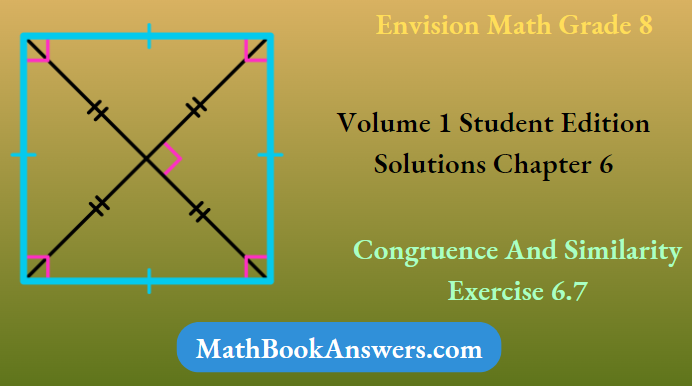
Envision Math Grade 8 Volume 1 Chapter 6.7 Solutions
Page 339 Exercise 2 Answer
Given: look for relationships is ΔABC a preimage of ΔA′B′C′
To find:
How do we know that the above statement is true.
In order to find that whether the statement is true or not we have to verify it with the help of tip mentioned above.
We can observe that ΔABC and ΔA′B′C′ both have the same shape, same orientation and same angles as well. The only difference between the two triangles is the difference in size.
Hence, we can say that ΔA′B′C′ is a dilation of ΔABC, and therefore ΔABC.
Yes, ΔABC is the preimage of ΔA′B′C′, since ΔA′B′C′ looks like the dilated version of ΔABC.
Page 339 Focus On Math Practices Answer
Given:ΔABC & ΔA′B′C′
To: How can you use the coordinates of the vertices of the triangles to identify the transformation that maps the triangles.
We will multiply the coordinates of the ΔABC with a scale factor k to obtain the triangle ΔA′B′C′. Now as the obtained triangle only differs by a scale factor of k in respect of given triangle hence it will have the same shape as that of ΔABC.
We will multiply the coordinates of the ΔABC with a scale factor k to obtain the triangle ΔA′B′C′.Now as the obtained triangle only differs by a scale factor of k in respect of given triangle hence it will have the same shape as that of ΔABC.
Congruence And Similarity Envision Math Exercise 6.7 Answers
Page 340 Convince Me Answer
Given:
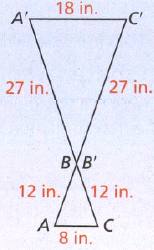
To: Convince what sequence of transformation makes the triangle similar.
Step formulation: Calculate the ratio of sides and then prove similarity
In last part we calculated the ratio of sides A′B′ to AB, ratio of A′C′ to AC and ratio of B′C′ to BC.
It is observed that the ratio of all three of the sides is equal to \(\frac{9}{4}\).
Hence on that basis it can be concluded that the triangles are similar.
As the ratio of sides are equal hence the triangles are similar.
Envision Math Grade 8 Chapter 6.7 Explained
Page 341 Try It Answer
Given:
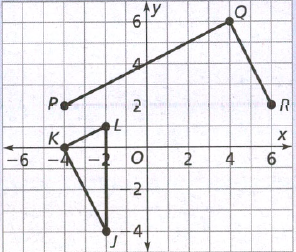
To: Find the reflection of JKL about x = 1 followed by dilation of \(\frac{1}{2}\).
Step formulation: Find the reflection of each point and then find the dilation.
Reflection of point L about x = 1.
i.e. the coordinates(−2,1) will become(4,1).
Reflection of point J about x = 1. will become
i.e. the coordinates(−2,−4)will become(4,−4).
Reflection of point K about x = 1.
i.e. the coordinates (−4,0) will become (6,0).
The transformed image is shown below.

For the dilation, the scale factor is \(\frac{1}{2}\).
So, \(\left(L^{\prime}\right)^{\prime}=\frac{4+4}{2}, \frac{1+(-4)}{2}\)
= 4, -1.5
Similarly(K′)′= 5,2
The dilated figure is:
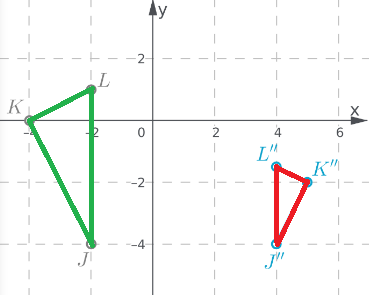
The dilated i.e. the last transformed image is:

Given:
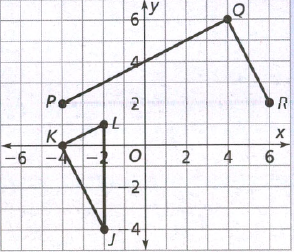
To: Prove ΔJKL is similar to ΔPQR. Step formulation: Find the ratio of sides.
Two-dimensional figure are similar if we can map one figure to the other by a sequence of rotations, reflections, translation, and dilations.
So, we found the sequence of transformations that map the ΔJKL onto ΔPQR :
translation for 8 units right and 1 unit up
rotation about point L
dilation with scale factor 2 about point L
Therefore, we can conclude that ΔJKL is similar to ΔPQR.
ΔJKL ~ ΔPQR
As all the three ratio of the sides are equal hence ΔJKL is similar to ΔPQR.
Page 342 Exercise 2 Answer
Given: Angles and side lengths of similar figures.
To: How do the angle measures and side lengths compare in similar figures?
In similar figures the corresponding angles must be equal.
Also the ratio of all corresponding sides must be equal.
In similar figures the corresponding angles must be equal.
Also the ratio of all corresponding sides must be equal.
Solutions For Envision Math Grade 8 Exercise 6.7
Page 342 Exercise 5 Answer
Given:
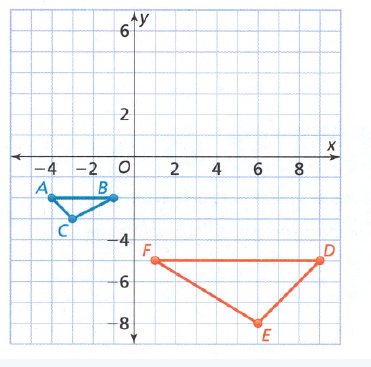
To: Obtain the final image by performing the given operations.
Step formulation: Graph each of the given steps and then obtain the final image.
ΔABC is dilated by a factor of 2 with a center of dilation at point C, reflected across the x axis, and translated 3 units up is shown in the below figure.
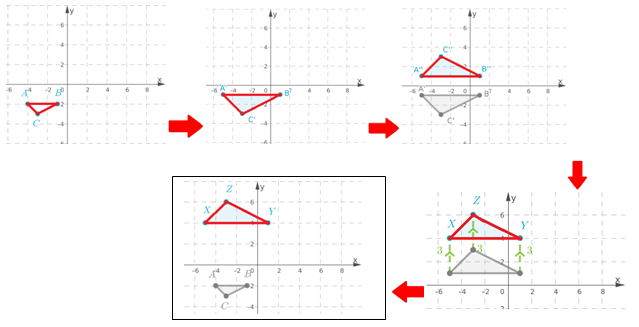
The graph obtained by performing sequence of operations is:

Page 342 Exercise 6 Answer
Given:
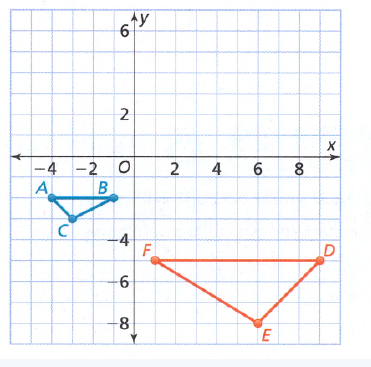
To: Find is the ΔABC similar to ΔDEF.
Step formulation: First find the length of the sides of the triangle and the find the ratio of corresponding sides.
Calculate the lengths of the sides of ΔABC & ΔDEF.
AB = \(\sqrt{(-1-(-4))^2+(-2-(-2))^2}\)
AB = 3
Similarly we can calculate the lengths of all sides.
BC = \(\sqrt{5}\)
CA = \(\sqrt{2}\)
DE = \(3 \sqrt{2}\)
EF = \(\sqrt{34}\)
FD = 8
The ratio between the longest sides i.e. between AB & FD = \(\frac{3}{8}\)
Ratio between BC & EF = \(\frac{\sqrt{5}}{\sqrt{34}}\)
As we can observe that the ratio of the sides is not equal, hence the triangles are not similar.
As we can observe that the ratio of the sides is not equal, hence the triangles are not similar.
Envision Math Grade 8 Volume 1 Chapter 6.7 Practice Problems
Page 343 Exercise 7 Answer
Given:
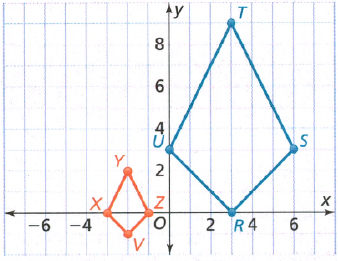
To: Describe a sequence of transformations that maps RSTU to VXYZ.
Step formulation: By taking reflection, translation and dilation, map both the triangles.
Since the figure RSTU is on the right of y axis, so, first lets take the reflection about y axis.
Now translate the obtained figure to left to 3 units.
Now translate the obtained figure to down to 3 units.
The figure obtained is:
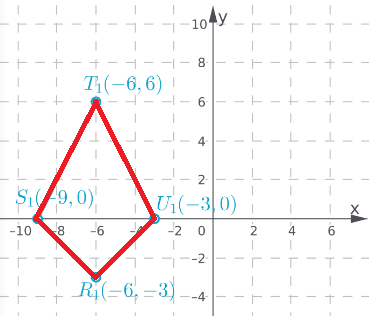
Now to map the images we need to do the dilation.
Coordinates of V = (−2,−1) and coordinates of R1 = (−6,−3).
Therefore, in order to match the figure it has to be reduce by factor 3.
So, \(R_1^{\prime}=\left(\frac{-6}{3}, \frac{-3}{3}\right)\)
R1‘ = (-2, -1)
So now the coordinates match. Similarly we can do for other vertices.
In order to map the images we did reflection about y axis then translation of 3 units to the left and down afterward the dilation of factor 3.
Envision Math 8th Grade Congruence And Similarity Topic 6.7 Key Concepts
Page 343 Exercise 8 Answer
Given:
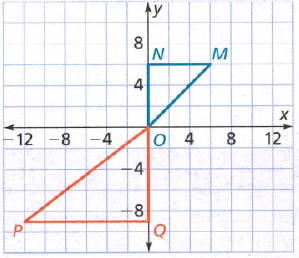
To: Is the shown triangles similar?
Step formulation: Find the ratio of the corresponding sides and then compare.
Find the length of the sides.
MN = 6
NO = 6
PQ = 12
OQ = 9
Now find the ratio of side.
As the ratio of sides is not equal, hence the triangles are not similar.
As the ratio of sides is not equal, hence the triangles are not similar.
Page 343 Exercise 9 Answer
Given:

To: Find the dilated and rotated image.
Step formulation: First find the coordinates after dilation and then rotate the figure.
Coordinates after dilation are:
P → 2(2,2) = 4,4
Q → 2(4,2) = 8,4
R → 2(3,4) = 6,8
So the dilated image is:
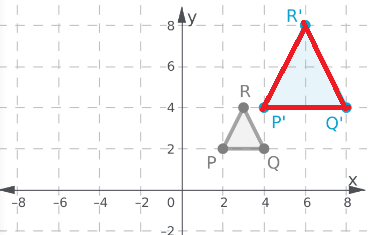
Now rotate the figure about the origin to 180∘.
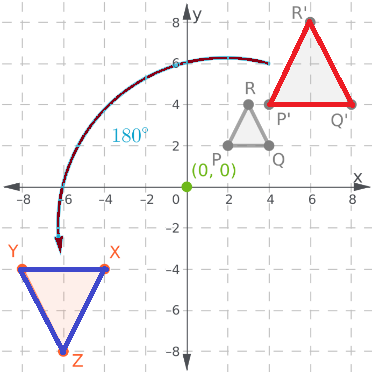
Final figure obtained by dilating and rotating about origin:

Page 344 Exercise 12 Answer
Given:

To: Find two possible coordinates for missing point Y.
For each coordinate chosen, describe a sequence of transformations, including a dilation, that will map the triangles.
Step fromulation: First locate point Y and then find the transformations.
Since the triangles are similar therefore,
\(\frac{J L}{L K}=\frac{X Z}{Z Y}\)Put the known in the expression.
\(\frac{6}{4}=\frac{3}{Z Y}\)Simplifying and finding ZY.
ZY = 2
Hence point Y will be 2 units away from Z in the horizontal direction. It’s coordinates are(−4,2).
Now to map ΔJLK with ΔXYZ transformations have to be taken.
Since both are equidistant from origin, therefore, mirror about origin will occur first.
Now after mirror dilation of factor \(\frac{1}{2}\)
ΔJLK will map with ΔXYZ.
Also the other coordinate of Y is (−4,5).
Possible coordinates of Y are(−4,2),(−4,5). To map the triangles, ΔJKL has to be mirred first then dilated by \(\frac{1}{2}\)
Envision Math Grade 8 Chapter 6.7 Lesson Overview
Page 344 Exercise 13 Answer
Given:
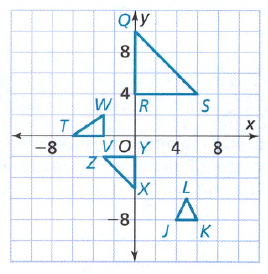
To: Which of the given triangles could Rajesh use for the pennants?
The triangles ΔQRS and ΔXYZ are similar because both have the same included angle and are the isosceles triangles. Both are right-angled isosceles triangles.
Whereas, ΔJKL is isosceles but does not have the same included angle, i.e. it is not right-angled; and it has no pair in the given options so it is not the answer. Also ΔWVT is right-angled, but is not isosceles and has no pair in the given options so it is not the answer.
Rajesh can use triangles given in option(B) ΔQRS & ΔXYZ for the pennants.
Envision Math Grade 8 Topic 6.7 Transformations Practice
Page 344 Exercise 14 Answer
Given:

To: Match the given options with similar or not similar.
ΔTVW & ΔQRS are both right angled isosceles triangle. Hence these are similar.
ΔJKL is not isosceles and is also not similar to any of the given triangles.
ΔTVW & ΔQRS are the similar triangles.
ΔTVW & ΔJKL are not similar triangles.
ΔJKL & ΔQRS are not similar triangles.
